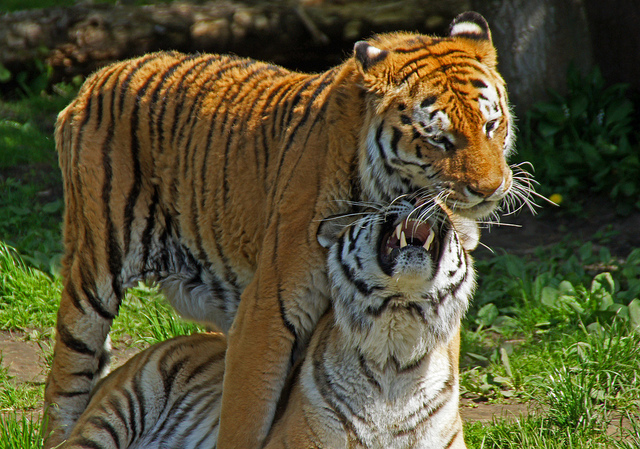Is the tiger a solitary animal?
Yes, 'tiger society, like that of most felids [cats], is characterized by individuals living and hunting by themselves' so writes Fiona Sunquist in Wild Cats of the World by Mel and Fiona Sunquist. So, tigers are essentially solitary animals. This is the definitive book on the wild cats by the way (buy it!). Tigers encounter each other from time to time when travelling along their trails and when patrolling their home ranges. They also meet for mating and occasionally they share a killed prey animal.
 |
| Tigers are solitary and come together for mating. Image in the public domain. |
But the only exception to the solitary life of the tiger is the mother caring for her young cubs.
Tigers hunt alone but there is a social system between these individuals which is maintained with various signals such as scrapings (visual signals), scent marks deposited by spraying urine and long-range calls (vocalisations).
These calls serve two purposes: to bring tigers together (for mating) and to keep each other apart! For the latter the calls indicate to others occupation of a space.
Tiger 'land tenure' (holding on to their home range, their territory) is believed to be flexible and dependent on the environmental circumstances.
RELATED: Tiger roar – intimidating, low frequency, long distance call.
In Chitwan National Park, in Nepal, for instance, tigresses establish relatively small 'exclusive ranges' (i.e., not shared) in which they hunt and raise their offspring.
The home range size varies between around 10 square kilometres and around 50 square kilometres with the variation due to lower prey density in the larger range.
Adult male tigers in Chitwan also maintain 'mutually exclusive territories' but they are much larger than for females at 2-15 times larger. This means that at the top end of size the male home range is 750 square kilometres. Note: imagine how a male tiger feels being in a zoo!
Siberian tigers have larger home ranges. Females might occupy 200-400 square kilometres and males 800-1,000 square kilometres in Sikhote-Alin which in the Far East of Russia near Vladivostock.
Each male home range overlaps with 1-3 female home ranges much like a harem. Female home ranges do not overlap.
RELATED: The Backyard Tiger – Big Cat Public Safety Act will end big cat abuse.
Tigers scent mark intensively when establishing their home range. One female sprayed the boundaries to her new home range 49 times each month.
Scent marks bring males and females together for mating purposes. Females are receptive to make advances for 2-3 days during her oestrous cycle.
Urine scent lays down a lot of information. The information depends on the context both spatial and social.
Of course, the domestic cat, the tiger's domestic cousin, is also solitary but they've adapted through thousands of years of domestication to become quite social in blending in which human society and often getting along in multi-cat homes. However, the solitary nature of cats sometimes causes lifelong friction in multi-cat homes.




Comments
Post a Comment
Please comment.